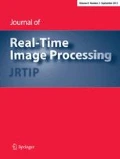Abstract
Augmented reality (AR) technology consists in adding computer-generated information (2D/3D) to a real video sequence in such a manner that the real and virtual objects appear coexisting in the same world. To get a realistic illusion, the real and virtual objects must be properly aligned with respect to each other, which requires a robust real-time tracking strategy—one of the bottlenecks of AR applications. In this paper, we describe the limitations and advantages of different optical tracking technologies, and we present our customized implementation of both recursive tracking and tracking by detection approaches. The second approach requires the implementation of a classifier and we propose the use of a Random Forest classifier. We evaluated both approaches in the context of an AR application for design review. Some conclusions regarding the performance of each approach are given.










Similar content being viewed by others
References
Barandiaran, I., Cottez, C., Paloc, C., Graña, M.: Random forest classifier for real-time optical markerless tracking. Proc. VISAPP 2, 559–564 (2008). ISBN:978-989-8111-21-0
Barandiaran, I., Cottez, C., Paloc, C., Graña, M.: Comparative evaluation of Random Forest and Fern classifiers for real-time feature matching. In: Proceedings of WSCG, pp. 59–166 (2008). ISBN:978-80-86943-15-2
Boffy, A., Tsin, Y., Genc, Y.: Real-time feature matching using adaptative and spatially distributed classification trees. Proc. BMVC 2, 529–539 (2006)
Breiman, L.: Random forests. Mach. Learn. J. 45, 5–32 (2001)
Chandaria, J., Graham, T., Stricker, D.: The MATRIS project: real-time markerless camera tracking for Augmented Reality and broadcast applications. J. Real Time Image Process. 2, 69–79 (2007). doi:10.1007/s11554-007-0043-z
Davison, A.J., Mayol, W., Murray, D.W.: Real-time localisation and mapping with wearable active vision. In: Proceedings of ISMAR (2003)
Fischler, M.A., Bolles, R.C.: Random sample consensus: a paradigm for model fitting with applications to image analysis and automated cartography. Commun. ACM 24, 381–395 (1981)
Hartley, R., Zisserman, A.: Multiple View Geometry in Computer Vision, 2nd edn. Cambridge University Press, London (2004). ISBN:0521-54051-8
Harris, C. Stephens, M.J.: A combined corner and edge detector. In: Alvey Vision Conference, pp. 147–152 (1988)
Lepetit, V., Pilet, J., Fua, P.: Point matching as a classification problem for fast and robust object pose estimation. In: Proceedings of CVPR, vol. 2, pp. 244–250 (2004). ISSN: 1063-6919
Lepetit, V., Fua, P.: Monocular model-based 3D object tracking of rigid objects: a survey. Found. Trends Comput. Graph. Vis. 1, 1–89 (2005)
Lepetit, V., Fua, P.: Keypoint recognition using randomized trees. IEEE Trans. Pattern Anal. Mach. Intell. 28(9), 1465–1479 (2006). ISSN: 0162-8828
Lowe, D.: Distinctive image features from scale invariants keypoints. Int. J. Comput. Vis. 20(2), 91–110 (2004)
Mikolajczyk, K., Tuytelaars, T., Schmid, C., Zisserman, A., Matas, J., Schaffalitzky, F., Kadir, T., Gool, L.V.: A comparison of affine region detectors. Int. J. Comput. Vis. 65(1–2), 43–72 (2005). ISSN: 0920-5691
Özuysal, M., Fua, P., Lepetit, V.: Feature harvesting for tracking-by-detection. In: Proceedings of European Conference on Computer Vision, pp. 592–605 (2006). ISBN:3-540-33836-5
Reitmayr, G., Schmalstieg, D.: OpenTracker: a flexible software design for three-dimensional interaction. Virtual Real. J. 9, 79–92 (2005). doi:10.1007/s10055-005-0006-2
Rosten, E., Drummond, T.: Machine learning for high-speed corner detection. In: Proceedings of European Conference on Computer Vision, pp. 430–443 (2006). ISBN:3540338322
Vacchetti, L., Lepetit, V., Fua, P.: Combining edge and texture information for real-time accurate 3D camera tracking. In: Proceedings of IEEE and AM International Symposium on Mixed and Augmented Reality, vol. 4, pp. 48–57 (2004). ISBN:0-7695-2191-6
Williams, B., Klein, G., Reid, I.: Real-time SLAM relocalisation. In: Proceedings of IEEE International Conference on Computer Vision, pp. 1–8 (2007)
Zhang, Z.: A flexible new technique for camera calibration. IEEE Trans. Pattern Anal. Mach. Intell. 22(11), 1330–1334 (2000). doi:10.1109/34.888718
Lepetit, V.: On computer vision for augmented reality. In: Proceedings of the International Symposium on Ubiquitous Virtual Reality, pp. 13–16 (2008)
Acknowledgments
This work has been partially funded under the sixth Framework Programme of the European Union (EU) within the project “IMPROVE”: IST FP6- 004785.
Author information
Authors and Affiliations
Corresponding author
Rights and permissions
About this article
Cite this article
Barandiaran, I., Paloc, C. & Graña, M. Real-time optical markerless tracking for augmented reality applications. J Real-Time Image Proc 5, 129–138 (2010). https://doi.org/10.1007/s11554-009-0140-2
Received:
Accepted:
Published:
Issue Date:
DOI: https://doi.org/10.1007/s11554-009-0140-2




